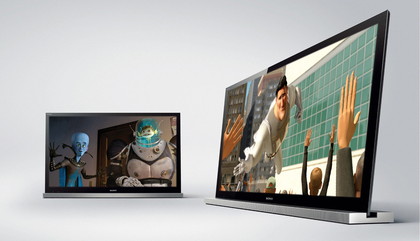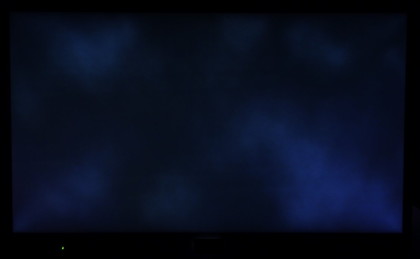Why you can trust TechRadar

The NX713 proves to be a demon on the test bench, acing trial after trial. Motion picture resolution is outstanding, and depending on the severity of MotionFlow picture processing selected, it's possible to preserve clarity right up to 1,080 lines.
To hit these giddy heights, select either the Clear or Clear Plus modes (the latter robs the screen of some brightness). Despite this amazing detail retention, there are only slight predictive motion artefacts around moving objects, which in most cases will go unnoticed.
Thankfully, it's not necessary to delve into the XMB to adjust the MotionFlow frame-rate settings, you can use the Option button on the remote; however, if you're using the screen with a Sony Blu-ray player you'll need to disable the CEC HDMI control, else the Option panel for the BD player will appear, rather than the one for the TV.
One challenging test, featuring scrolling English and Japanese text, was brushed aside by the panel. At 100, 50 and 30 per cent luminance the moving characters remain perfectly legible with no smudging.
This TV is also exceptionally smooth when it comes to pans. There's precious little cinematic judder, even with all the picture processing gubbins turned off; an artful sequence from Disney's Sleeping Beauty (Blu-ray) wherein Prince Charming canters behind a rocky outcrop, passes smoothly without incident or artefact.
Engage MotionFlow and scrolling sequences are as smooth as can be, without so much of a smudge of halo artefacts.
Another big surprise is just how good this set is when viewed off axis. Even at an extreme angle, there's no massive fall-off in colour or contrast. Indeed, the NX713 behaves much like an IPS (In Plane Switching) LCD screen.
Sign up for breaking news, reviews, opinion, top tech deals, and more.
Naturally, the set has a Freeview HD tuner. This means subscription free high definition from BBC One HD, BBC HD, ITV 1 HD and C4HD is only ever a click away.
While Freeview HD channels don't tend to stand comparison with Blu-ray, they are nonetheless free from the kind of macro-blocking and fuzz that makes standard Freeview look so rank. An HD transmission of Star Wars: Attack of the Clones is wonderfully detailed.
On the debit side, the edge LED backlight is not particularly even, although there are plenty of worse examples on the market. Under most circumstances this flaw isn't particularly noticeable, but play a movie in letterbox format or catch a slow fade to black and you'll notice light pooling from the corners.
The image presented here reveals just how uneven the backlight is, although taken with a slow shutter it does tend to emphasise the problem.

Black levels and contrast, meanwhile, can be considered above average. So what's the 40NX713 like in 3D? The screen offers a couple of 3D adjustment controls. You can alter the brightness of the Active Shutter glasses, from Auto to High or Medium. There's also a depth adjustment tool, which has two plus or minus increments, either side of the default.
Rather unhelpfully, when you elect to adjust this setting 50 per cent of the screen remains obscured by the menu, so you can't really see what you're doing.
Unfortunately, none of the controls will help you dial crosstalk out of a 3D image. In the TV's default 3D setting, the church steeple at the beginning of Monsters vs Aliens has clear secondary spires.
This image overlap can be fixed by adjusting for negative parallax using the Depth Adjustment tool, but then everything in zero or parallel parallax is thrown out of whack. Crosstalk remains an issue, regardless of how you tinker.
On the sublime Blu-ray promotional edition of Avatar, double imaging effects are far less prevalent. They're there if you look for them, just not so intrusive. Of course, with precious little 3D content available, you might well be tempted to play with the set's real-time 2D to 3D converter.
This takes any flat source, from over the air TV to discs and games, and dimensionalises it. The TV offers variable levels of simulated 3D depth, but even on the High setting you're unlikely to be impressed.
Sony's 3D Active Shutter glasses are nicely designed and relatively comfortable (in an uncomfortable kind of way).Spectacle wearers will find them a tight fit, though.
Current page: Sony KDL-40NX713 review: Performance
Prev Page Sony KDL-40NX713 review: Ease of use Next Page Sony KDL-40NX713 review: Sound and value
Steve has been writing about AV and home cinema since the dawn of time, or more accurately, since the glory days of VHS and Betamax. He has strong opinions on the latest TV technology, Hi-Fi and Blu-ray/media players, and likes nothing better than to crank up his ludicrously powerful home theatre system to binge-watch TV shows.
